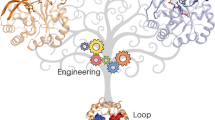Abstract
Protein engineering is being used increasingly to study the fine details of the structure and activity of enzymes. How can small effects of mutation on activity be reliably quantified and systematized, and artefacts be recognized? A traditional means of doing this in organic chemistry is the use of linear free-energy relationships that link changes in rate constant for a reaction to changes in its equilibrium constant as the structure of the reagents is altered—Brønsted or Hammett plots1. We now find that the same type of plot may be applied to enzymatic reactions for variation of the structure of an enzyme with mutation. The activities of many mutant tyrosyl-transfer RNA synthetases fit structure-activity relationships which relate the rate constant for the formation of enzyme-bound tyrosyl adenylate (E.Tyr–AMP) to its equilibrium constant with enzyme-bound tyrosine and ATP (E.Tyr. ATP). This reaction results in an increase in binding energy between certain side chains of the enzyme and the side chain of tyrosine and the ribose ring of ATP. Plots of rate against equilibrium constant for a series of enzymes mutated in the relevant positions indicate that 71% of the binding energy change occurs on formation of the transition state for the chemical reaction and 90% occurs on formation of the E.Tyr–AMP.PPi complex. Other mutations show a different behaviour which is diagnostic of residues that specifically bind the transition state. Linear free-energy plots show trends and allow exceptions to be readily noted. That the activities of a large number of mutants conform to linear free-energy equations is the best evidence yet that mutation of an enzyme can probe general properties and trends in the relationship between structure and activity.
This is a preview of subscription content, access via your institution
Access options
Subscribe to this journal
Receive 51 print issues and online access
$199.00 per year
only $3.90 per issue
Buy this article
- Purchase on Springer Link
- Instant access to full article PDF
Prices may be subject to local taxes which are calculated during checkout
Similar content being viewed by others
References
Jencks, W. P. Chem. Rev. 85, 511–517 (1985).
Winter, G., Fersht, A. R., Wilkinson, A. J., Zoller, M. & Smith, M. Nature 299, 756–758 (1982).
Fersht, A. R. et al. Angew. Chem. int. Edn Engl. 23, 467–473 (1984).
Fersht, A. R. et al. Nature 314, 235–238 (1985).
Leatherbarrow, R. J., Winter, G. & Fersht, A. R. Proc. natn. Acad. Sci. U.S.A. 82, 7840–7844 (1985).
Wells, T. N. C. & Fersht, A. R. Nature 316, 656–657 (1985).
Wells, T. N. C. & Fersht, A. R. Biochemistry 25, 1881–1886 (1986).
Ho, C. K. & Fersht, A. R. Biochemistry 25, 1891–1897 (1986).
Fersht, A. R. Enzyme Structure and Mechanism 2nd edn, Ch. 12 (Freeman, San Francisco, 1985).
Waye, M. M. Y., Winter, G., Wilkinson, A. J. & Fersht, A. R. EMBO J. 2, 1827–1829 (1983).
Author information
Authors and Affiliations
Rights and permissions
About this article
Cite this article
Fersht, A., Leatherbarrow, R. & Wells, T. Quantitative analysis of structure–activity relationships in engineered proteins by linear free-energy relationships. Nature 322, 284–286 (1986). https://doi.org/10.1038/322284a0
Received:
Accepted:
Issue Date:
DOI: https://doi.org/10.1038/322284a0
This article is cited by
-
Physical constraints and functional plasticity of cellulases
Nature Communications (2021)
-
Structural correlates of affinity in fetal versus adult endplate nicotinic receptors
Nature Communications (2016)
-
Mapping the sequence of conformational changes underlying selectivity filter gating in the Kv11.1 potassium channel
Nature Structural & Molecular Biology (2011)
-
Probing Structure–Function Relationships of Serine Hydrolases and Proteases with Carbamate and Thiocarbamate Inhibitors
The Protein Journal (2006)
-
Describing Partially Unfolded States of Proteins from Sparse NMR Ddata
Journal of Biomolecular NMR (2005)
Comments
By submitting a comment you agree to abide by our Terms and Community Guidelines. If you find something abusive or that does not comply with our terms or guidelines please flag it as inappropriate.



